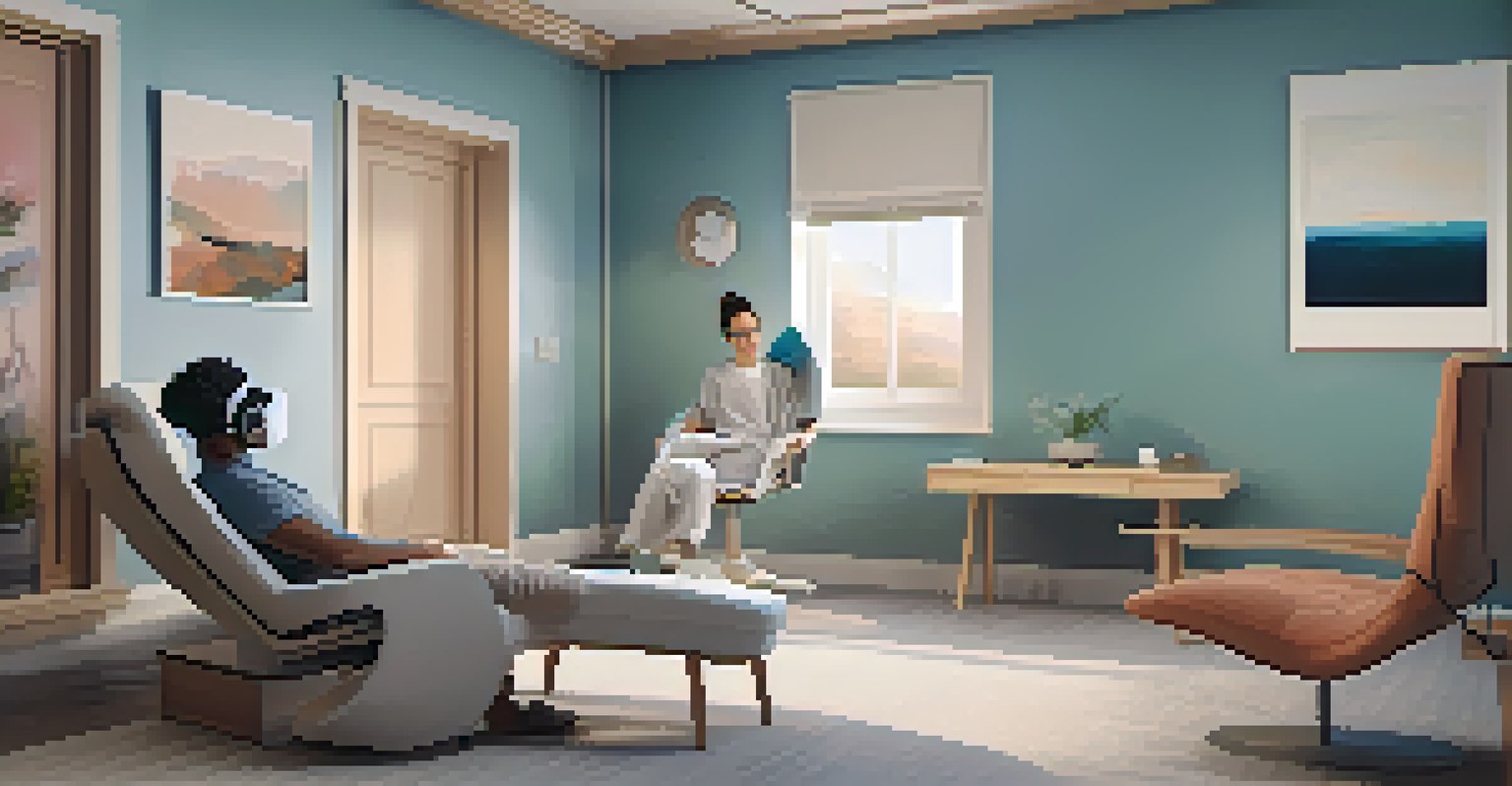Virtual Reality in Therapy: Immersive Experiences for Healing

Understanding Virtual Reality and Its Therapeutic Benefits
Virtual Reality (VR) is an interactive technology that immerses users in a computer-generated environment. This immersive experience can make therapy more engaging and effective for patients. By simulating real-world scenarios, VR helps individuals confront and process their feelings in a safe space.
Virtual reality is a technology that can help us redefine therapy and make the healing process more engaging and effective.
One of the primary benefits of VR in therapy is its ability to provide exposure therapy. For example, someone with a fear of flying can experience a simulated flight, gradually desensitizing them to their anxiety. This method can be much less intimidating than traditional exposure therapy.
Additionally, VR can enhance the therapeutic experience by offering a level of distraction that traditional methods may lack. Patients can explore soothing environments, such as calming beaches or serene forests, which can help reduce stress and improve overall mental well-being.
Applications of VR in Various Therapeutic Settings
VR is being used in various therapeutic contexts, including treating anxiety, PTSD, and phobias. In these settings, therapists can create scenarios tailored to each patient’s specific needs, making the therapy more personalized and effective. For instance, a patient with PTSD can revisit traumatic events in a controlled and safe manner.

Moreover, VR is also beneficial in pain management. It can distract patients from their pain during procedures or rehabilitation, making the experience less daunting. For example, patients undergoing physical therapy may engage in a VR game that encourages movement while keeping their mind off the discomfort.
VR Enhances Therapy Engagement
Virtual Reality immerses patients in simulated environments, making therapy more engaging and effective.
Another application lies in social skills training for individuals on the autism spectrum. VR can simulate social interactions, providing a safe practice ground for developing communication skills without the pressure of real-life social settings.
The Science Behind VR Therapy Effectiveness
Research indicates that VR therapy can lead to significant improvements in mental health. Studies show that patients often report lower anxiety levels and improved coping strategies after VR sessions. This can be attributed to the immersive quality of VR, which allows for a deeper emotional connection to the therapeutic process.
The power of virtual reality lies in its ability to immerse individuals in environments that promote healing and personal growth.
Furthermore, the brain’s ability to adapt and change (neuroplasticity) plays a crucial role in VR therapy. By repeatedly exposing patients to virtual environments, therapists can help reshape how their brains respond to stressors. This can lead to lasting changes in behavior and thought patterns.
In addition, the physiological responses to VR experiences—like increased heart rate or sweating—can actually mirror those experienced in real-life situations. This similarity can enhance the therapeutic effect, making the transition from virtual to reality smoother for patients.
Challenges and Considerations in VR Therapy
While VR offers exciting possibilities, it also comes with challenges. One significant concern is the potential for motion sickness or discomfort during use. Therapists must carefully monitor how patients respond to VR to ensure that the experience remains positive and beneficial.
Additionally, access to technology can be a barrier for some patients. Not everyone has the means to access VR equipment, which could potentially widen the gap in mental health care. Therapists may need to find creative solutions to ensure that all patients can benefit from this innovative approach.
Personalized Treatment Options
VR allows therapists to create tailored scenarios for various mental health conditions, enhancing the therapeutic experience.
Finally, there’s the need for ongoing research to establish best practices in VR therapy. As the technology evolves, therapists must stay informed about the latest developments to provide the most effective care possible.
VR Therapy: A Complement to Traditional Approaches
It's important to note that VR therapy isn’t a replacement for traditional methods, but rather a complement to them. Many therapists are integrating VR into existing practices to enhance patient outcomes. This hybrid approach can lead to more comprehensive treatment plans that address a wider range of symptoms.
For instance, combining VR with cognitive-behavioral therapy (CBT) can help patients confront their fears while also learning coping strategies. This multifaceted approach can be particularly effective for patients dealing with anxiety or phobias.
Moreover, as therapists gain experience with VR, they can tailor the technology to fit individual patient needs, creating a more personalized therapeutic experience that resonates with each person.
The Future of VR in Therapeutic Practices
The future of VR in therapy is promising, with ongoing advancements in technology and research. As VR becomes more accessible and affordable, we can expect to see it integrated into more treatment programs. This could lead to a revolution in how mental health care is delivered, making it more engaging and effective.
Innovations like wireless headsets and improved software are making VR experiences more user-friendly, which can help therapists incorporate them into their practices with ease. As these technologies evolve, the potential applications for VR in therapy will continue to expand.
Complementing Traditional Therapy
VR is not a replacement but a valuable addition to traditional therapy methods, providing a multifaceted approach to treatment.
Ultimately, the goal is to leverage VR to create effective, personalized, and engaging therapeutic experiences that can help individuals on their healing journeys.
Real-Life Success Stories with VR Therapy
Many individuals have experienced transformative changes through VR therapy. For example, a veteran suffering from PTSD found relief by using VR to recreate and process traumatic memories in a controlled environment. This approach allowed him to face his fears gradually and ultimately regain control over his life.
Another success story involves a young woman with severe social anxiety who used VR to practice social interactions in a safe setting. Over time, she gained confidence and learned to navigate real-world situations more effectively, illustrating how powerful VR therapy can be.

These real-life examples highlight the potential of VR to make a meaningful difference in people's lives. As more stories emerge, they reinforce the importance of continuing to explore and develop VR as a vital tool in therapeutic practices.